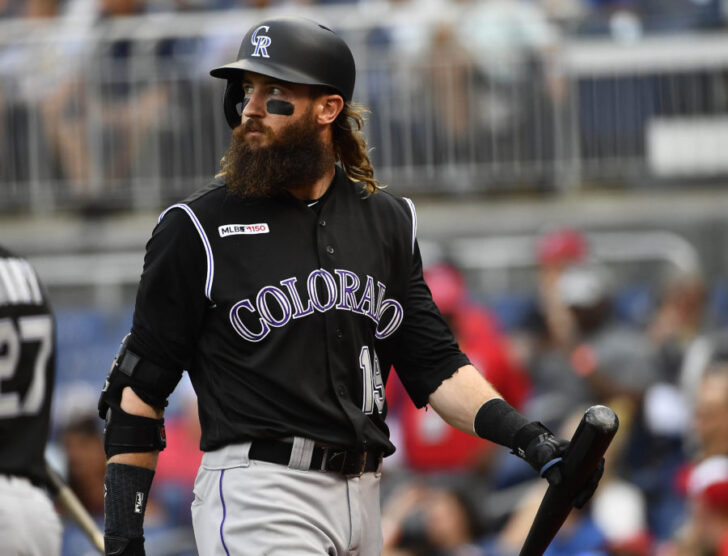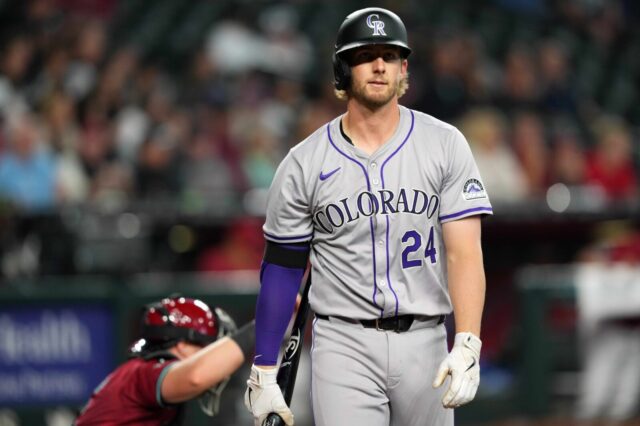There’s a rumor going around. In the thick of the Major League Baseball deadline bonanza, it’s merely one of many.
As those whispers would suggest, Charlie Blackmon is up for grabs. Though the rumor says that the Colorado Rockies would listen to offers, it would behoove them to stay put in regards to the all-star.
On the open market, the veteran outfielder carries significantly less value to other teams than the one he’s currently on. Trading him would cause more strife than the potential payoff would warrant.
What is that trade value? In short: it’s complicated.
For any Rockies’ hitter, the internal value is perceived to be greater. With Coors Field looming, on a yearly basis, the home/road splits of the club are extreme.
There’s a variety of reasons. The largest outfield in the league plays a role. Breaking balls doing less ‘breaking’ is another one.
While the counterargument – which is a valid one – would state that those same hitters have to deal with constant adjustment to greater pitch movement on the road, it’s largely a moot point to opposing front offices. The other teams in the league choose the price in a deal, while the Rockies’ power lies in their finagling and searching ability.
Ironically, Blackmon’s splits this year are eye-popping.
At home, the outfielder has had an impact that rivals the late Tony Gwynn. With his average at .415 through 38 home bouts, Blackmon’s a pitcher’s worst nightmare in the confines at 20th and Blake.
Among the league’s elite at their home ballparks, none have registered a higher average. The Red Sox’ Xander Bogaerts – who’s in second place – is only at .370.
Blackmon’s 16 homers at home rank fourth in the majors, while his slugging percentage (.848) is the top mark.
When looking across the splits though, the road numbers are middling.
At various parks away from Coors, Blackmon has slashed .251/.285/.403. That line includes five home runs, 46 punchouts and only six walks.
The comparison is staggering.
Blackmon’s slugging mark is over two times greater at home. The batting average difference is akin to the gap between the 1941 iteration of Ted Williams and the modern-day Niko Goodrum. With respect to the latter, it’s a seismic swing.
The truth is: Blackmon is likely somewhere in the middle.
For the year, his weighted runs created, when adding park and league adjustments (wRC+) is 28th (132). Surrounding him on the leaderboard are Matt Chapman (134), Austin Meadows (132) and even Mookie Betts (134).
It’s clear that regardless of the park, Blackmon is just a good hitter. From the leadoff spot, his power is a catalyst for a club’s offensive success, while the talks he has with the younger players on the team after an at-bat play a role as well.
A problem that counters Blackmon’s status as an elite player, regardless of the park, is the runs he gives away.
Last year, while perched in center field, Blackmon’s defensive runs saved above an average outfielder was -28. That mark was last among the league’s outfielders.
After the underwhelming year defensively, the club moved Blackmon to right field – likely the smallest portion of Coors’ outfield. The change has paid dividends to a degree.
At a far greater runs saved mark of -6 so far, Blackmon ranks 10th-worst among the league’s right fielders in 2019.
The obvious trade partner with Blackmon’s deficiencies on defense would be an American League club. As a designated hitter, the reps for the veteran in his new club’s outfield would likely be limited.
The last area of critique for another front office would be Blackmon’s age and contract status.
On July 1st, Blackmon turned 33 years old. While not a death sentence for trade talks, the value of an outfielder that’s north of 30 is somewhat limited.
When you add in the fact that that same outfielder is set to make $21.3 million each of the next two years, as well as a player option for his age 36 and 37 years, that limited value is subtracted further.
That leaves Jeff Bridich and company in a tough spot.
If they deal Blackmon, he’d likely fetch a somewhat decent haul of maybe one or two of a fellow franchise’s good prospects, as well as a wild card or two from the lower levels of that same farm system. Seeking an asset that’s already in the majors from a contending team would likely result in severed trade talks.
Does that really help the Rockies?
Nolan Arenado’s contract features an opt-out clause. That opportunity to depart the club for greener pastures comes following the 2021 season – only two years after the current campaign ends.
The prospects that could be acquired in a deal for Blackmon would likely fail to make a sizeable impact in that time frame. Expecting the current outfielders in the Rockies’ system to pick up the slack would be foolhardy as well.
Trading Blackmon, in a sense, is also giving a larger and more favorable window for Arenado to leave. Without a visible desire to win, as shown by the possible choice to move Blackmon, the club could lose both players by 2022 for little-to-no return.
When put in context, the results of a possible trade are gloomier than the club’s current outlook already.
Keeping an outfielder that can carry a club singlehandedly during stretches at his home ballpark is far more advantageous.



